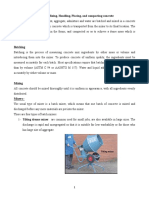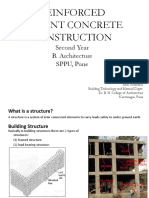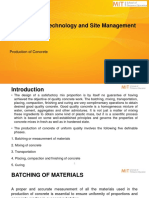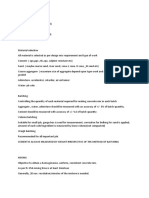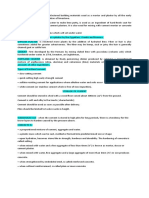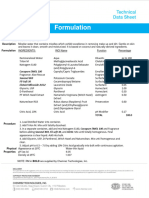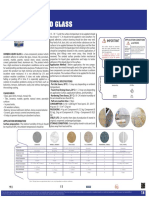0 ratings0% found this document useful (0 votes)
5 viewsCONCRETE
The document provides an overview of concrete materials and the production process of concrete, including batching, mixing, transportation, handling, placing, and curing. It discusses the composition of concrete, the importance of proper mixing and compaction, and the role of curing in achieving strength and durability. Additionally, it categorizes concrete based on various factors such as density, cementing material, and production methods, emphasizing the significance of each stage in creating high-quality concrete.
Uploaded by
ifwgfhzfkCopyright
© © All Rights Reserved
We take content rights seriously. If you suspect this is your content, claim it here.
Available Formats
Download as PDF, TXT or read online on Scribd
0 ratings0% found this document useful (0 votes)
5 viewsCONCRETE
The document provides an overview of concrete materials and the production process of concrete, including batching, mixing, transportation, handling, placing, and curing. It discusses the composition of concrete, the importance of proper mixing and compaction, and the role of curing in achieving strength and durability. Additionally, it categorizes concrete based on various factors such as density, cementing material, and production methods, emphasizing the significance of each stage in creating high-quality concrete.
Uploaded by
ifwgfhzfkCopyright
© © All Rights Reserved
We take content rights seriously. If you suspect this is your content, claim it here.
Available Formats
Download as PDF, TXT or read online on Scribd
You are on page 1/ 55
BUILDING CONSTRUCTION PRACTICE &
CONCRETE TECHNOLOGY
CHAPTER - 2
CONCRETE MATERIALS:
Production of concrete:
Batching, Mixing, Transportation, Handling, Placing
And Curing Of Concrete & Methods Of Curing. Water
Cement Ratio,Gel Space Ratio
Concrete a composite man-made material, is the most widely
used building material in the construction industry.
It consists of a rationally chosen mixture of binding material
such as lime or cement, well graded fine and coarse
aggregates, water and admixtures (to produce concrete with
special properties).
In a concrete mix, cement and water form a paste or matrix
which in addition to filling the voids of the fine / coarse
aggregate, coats the surface of fine and coarse aggregates
and binds them together.
Freshly mixed concrete before set is known as wet or green
concrete whereas after setting and hardening it is known as set
or hardened concrete.
Some concepts for better understanding
Concrete, usually Portland cement concrete, is a composite
material composed of fine and coarse aggregate bonded
together with a binder called cement (cement paste, WHICH
MEANS WE HAVE WATER ALSO) that hardens over time.
Phase diagram of concrete can be shown below
AIR VOIDS
The moulded concrete mix after sufficient curing
becomes hard like stone due to chemical action
between the water and binding material. [REMEMBER
HYDRATION OF CEMENT AND ITS COMPOUNDS]
Most of the ancient structures and historical
buildings had been constructed with lime concrete.
With the advent of cement, the use of lime concrete
has been confined to making bases for concrete
foundations and roof terracing. [REMEMBER MORTAR
WHERE LIME MORTAR HAS BEEN COMPLETELY
REPLACED BY CEMENT MORTAR]
The question is why has LIME become outdated?
The major factors responsible for wide usage of cement-
concrete are MOUldability, early hardening, high early
compressive strength, development of desired properties
with ADMIXTURES to be used in adverse situations,
suitability for grouting, guniting, pumpability and
durability.
Hence in the course work we will concentrate in the
entirety to CEMENT CONCRETE.
The QUEstion is what is admIXTURE?
r r r r r
Based on cementing material: Concretes are classified
as lime concrete, gypsum concrete and cement
concrete.
Based on BUlk Density: On the basis of density,
concrete is classified as super heavy (over 2500
kg/m3), dense (1800-2500 kg/m3), light weight
(500–1800 kg/m3) and extra light weight concrete
(below 500 kg/m3).
Based on perspective specification: The cement concrete is
specified by proportions of different ingredients, e.g.,
1 (cement) : 1.5 (fine aggregate) : 3 (coarse aggregate).
[M 20, grade concrete]
It is presumed that by adhering to such perspective
specifications satisfactory performance may be achieved. The
usual mix proportions of cement concrete are given in Table.
This type of concrete mix is also known as NOMINAL MIX.
Example, M 10, M 20 where, “M” refers to the mix. Even
today such specifications is present in field.
However today, Conventional NOMINAL MIX proportions
have limited significance, since the quantity of fine aggregate
is fixed irrespective of the cement content, water-cement ratio
and the maximum size of aggregate to be used.
Based on performance oriented specification: When the concrete
properties such as strength, water-cement ratio, compaction
factor, slump, etc., are specified the concrete may be classified
as DESIGNED-MIX CONCRETE. For a design mix concrete the
mix is designed to produce the grade of concrete having the
required WORKABILITY and A CHARACTERISTIC STRENGTH
not less than the appropriate values as specified in Table
Based on Grade of CEMENT CONCRETE: Depending upon
the strength (N/mm2) of concrete cubes (150 mm side) at
28 days, concrete is classified as given in Table.
Based on place of casting of cement concrete: When
concrete is made and placed in position at the site it is
known as in-situ concrete and when used as a material for
making prefabricated units in a factory is known as
precast concrete.
Picture of VERTICAL BATCHING PLANT
[In-situ concrete preparation]
PRODUCTION OF CONCRETE
A good quality concrete is essentially a homogeneous
mixture of cement, coarse and fine aggregates and
water which consolidates into a hard mass due to
chemical action between the cement and water.
Each of the four constituents has a specific function.
The coarser aggregate acts as a filler.
The fine aggregate fills up the voids between the paste and
the coarse aggregate.
The cement in conjunction with water acts as a binder.
The mobility of the mixture is aided by the cement paste, fines and
nowadays, increasingly by the use of admixtures.
STAGES OF CONCRETE PRODUCTION
The stages of concrete production are
Batching or MeASUREMENT of materials
Mixing
Transporting
Placing
Compacting
Curing
Finishing
For good quality concrete a proper and accurate
quantity measurement / Proportioning of all the
ingredients should be used.
There are two prevalent methods of batching
materials,
the volume batching and
the weigh batching
The factors affecting the choice of batching method
are the size of job, required production rate, and
required standards of batching performance.
For most important works weigh batching is
recommended.
Volume batching is generally recommended for
small jobs only. The amount of each solid ingredient
is measured by loose volume using standard box
known as gauge box.
The amount of solid granular material in a cubic
meter will be an indefinite quantity. [Each time you
take there is no way you will get same quantity] As an
example, volume of moist sand in a loose condition
weighs much less than the same volume of dry
compacted sand.
However, Cement is always measured by weight,
irrespective of the method of batching.
The volume of a bag of cement (50 kg) is 0.035 m3.
The volume of one gauge box is made equal to
0.035 m3. The gauge boxes are made
comparatively deeper with narrow top surface to
facilitate easy estimation of top level. Correction to
the effect of bulking of fine aggregate should be
made if volume batching is adopted since the
density of water is in kg/ m3 or L, water is measured
either in kg or litres. [1 Kg of water = 1 litre]
For all important works weigh batching is used.
The concrete ingredients are batched/
proportioned based on weight.
Different types of weigh batchers are used.
For smaller works manual batching is done.
For large size works weigh bucket equipment's are
used.
Automatic batching plants ranging from small to
large capacity and manually or electrically
operated are available.
The object of mixing is to make the concrete mass
homogeneous and uniform in colour and consistency.
All the aggregate particles should have a coat of
cement paste and all the ingredients of the concrete
should blend into a uniform mass.
The mixing is done either by hand or by machine
called mixer.
Hand mixing is used for small jobs.
For quality works mixing is carried out by mixer, which
can be further classified into Batch mixer and
Continuous mixer.
Types of Mixers
The batch mixers produce concrete batch by batch with time
interval, whereas continuous mixers produce concrete
continuously till plant is working.
Batch mixer may be of pan type or drum. The drum type
[Most commonly seen on construction works] may be further
classified as tilting (T), non-tilting (NT), or reversing (R) type,
based on the technique of discharging the mixed concrete.
These are designated by a number representing its nominal
mixed batch capacity in litres.
The standard size of the mixers available are as follows:
Tilting: 85T, 100T, 140T, 200T
Non-tilting: 200NT, 280NT, 340NT, 400NT, 800NT
Reversing: 200R, 280R, 340R, 400R.
Truck mounted mixers also know as transit mixers
popular. Transit mixers of capacity 4 to 12 cum
mounted on truck chassis are available.
These mixers are not very efficient and need long
mixing duration depending on the extent of dryness
in the mix. Their function is mainly to keep the mix in
an agitated condition. However, with improvement in
technology, production of high quality structural
concrete in the transit mixer is possible at a faster
rate.
Chasis of truck (Pictorial representation)
3. TRANSPORTATION
Concrete should be transported to the place of
deposition at the earliest without the loss of
homogeneity obtained at the time of mixing.
A maximum of 2 hours from the time of mixing is permitted if
trucks with agitator and
1 hour if trucks without agitators are used for transporting
concrete.
Also it should be ensured that segregation does not
take place during transportation and placement.
The methods adopted for transporting concrete
depend upon the size and importance of the job, the
distance of the deposition place from the mixing
place, and the nature of the terrain. Some are Motor
pan, Wheel Barrow, Skip and Hoist, Chutes etc.,.
Pictorial representations for transport of
concrete
To achieve quality concrete it should be placed
with utmost care securing the homogeneity
achieved during mixing and the avoidance of
segregation in transporting.
Research has shown that a delayed placing of
concrete results in a gain in ultimate compressive
strength provided the concrete can be adequately
compacted.
For dry mixes in hot weather delay of half to one
hour is allowed whereas for wet mixes in cold
weather it may be several hours.
After concrete is placed at the desired location, the next
step in the process of concrete production is its
compaction.
Question is why is it required ?
Considerable quantity of air is entrapped in concrete
during its production and there is possible partial
segregation also. Both of these adversely affect the
quality of concrete.
Definition: Compaction of the concrete is the process to
get rid of the entrapped air and voids, elimination of
segregation occurred and to form a homogeneous dense
mass.
What is the effect or air and voids in hardened concrete
OR what is the effect of UNCOMPACTED concrete?
It has been found that 5 per cent voids in hardened
concrete reduce the strength by over 30 per cent and 10
per cent voids reduce the strength by over 50 per cent.
Therefore, the density and consequently the strength and
durability of concrete largely depend upon the degree
of compaction. For maximum strength concrete should be
compacted 100 per cent.
Also The voids increase the permeability of concrete. Loss
of impermeability creates easy passage of moisture,
oxygen, chlorides, and other aggressive chemicals into the
concrete. This causes rusting of steel [ESPECIALLY IN
RCC] and spalling (disintegration) of concrete i.e., loss
of durability.
How?
Easy entry of sulphates from the environment causes
expansive reaction with the tricalcium aluminate (C3A)
present in cement [ESPECIALLY OPC]. This causes
disintegration of concrete and loss of durability.
Entry of carbon dioxide causes carbonation of concrete
i.e., loss of alkalinity of concrete or loss of the protective
power that concrete gives to the reinforcement or other
steel embedded in it. Once the carbonation depth
exceeds the thickness of concrete cover to the embedded
steel, steel becomes vulnerable to the attack of moisture.
This expedites rusting of steel as the protective concrete
cover remains no longer alkaline in nature.
Sulphate attack on concrete
(Pictorial representation)
Contd…
Voids also reduce the contact between embedded steel
and concrete. This results in loss of bond strength of
reinforced concrete member and thus the member loses
strength. Voids such as honeycombs and blowholes on the
exposed surface produce visual blemish. Concrete
surface is not good to look with all such blemishes. Concrete
with smooth and perfect, surface finish not only looks
good but is also stronger and more durable.
Ok then, How do we do compaction ???
Compaction is achieved by imparting external work over
the concrete to overcome the internal friction between
the particles forming the concrete, between concrete
and reinforcement by reducing the air voids to a
minimum. Methods include Hand compaction,
Compaction by vibration, Compaction by jolting.
Honeycomb and Blowholes
(Typical pictorial representation)
Compaction methods on concrete
(Pictorial representation only)
Curing is the process in which the concrete is protected
from loss of moisture and kept within a reasonable
temperature range. The result of this process is increased
strength and decreased permeability.
Why is it required exactly ??
Cement gains strength and hardness because of the
chemical action between cement and water
[REMEMBER C-S-H gel formation].
This chemical reaction requires moisture, favourable
temperature and time [REMEMBER TIME IS REQUIRED
FOR GAIN OF STRENGTH] referred to as the curing
period.
Curing of freshly placed concrete is very important for
optimum strength and durability. The major part of the
strength in the initial period is contributed by the clinker
compound C3S and partly by C2S, and is completed in about
three weeks.
The later strength contributed by C2S is gradual and takes
long time. As such sufficient water should be made available to
concrete to allow it to gain FULl strength.
The objective of curing is thus to prevent the loss of moisture
from concrete due to evaporation or any other reason, and
further supply additional moisture to accelerate the gain of
strength.
Curing must be done for at least three weeks and in no case
for less than ten days.
Development of strength with Age
Development of strength with moist
curing / air curing
Various methods of curing
IN CBIT CAMPUS
CLOSE TO
CANTEEN
6. FINISHING
Concrete is basically used because of its high
compressive strength. However, the finish of the
ultimate product is not that pleasant.
However, today due to many advances, the exterior
surfaces of concrete elements can be modified to
give a pleasant look.
For example, The concrete surface is roughened,
cleaned and wetted. Over this a cement mortar of
ratio 1:3 is applied.
Pictorial representation of finishing
ROLE OF WATER IN CONCRETE
Needed for two purposes:
Chemical reaction with cement
Workability
Sufficient amount of water is Good for preventing plastic
shrinkage cracking and improves workability.
However excess water is Bad for permeability, strength,
durability.
pH value of water used for mixing and curing shall
not be less than 6, under any circumstances.
[as per IS 456]
IMPORTANT
CONCEPTS
PROPORTIONING
PROPORTIONING
The principle object of accurate measurement of ingredients
or proportioning concrete is to achieve requisite strength with
desired workability for which due attention should be paid to
the selection of cement and aggregates according to the
specifications. Concrete mix design is done for correct
proportioning. Some of the considerations to be taken note of
are:
1) The mix must be workable so that it can be placed and compacted
without extra effort.
2) High cement content improves strength, impermeability, density and
workability.
3) With cement content, ingredients and workability remaining
constant, the strength and impermeability of concrete increase with the
density of mix.
WATER
TO
CEMENT
RATIO
WATER CEMENT RATIO (W/C ratio)
The water-cement ratio (w/c) is one of the major
factors influencing the strength of concrete.
It is responsible mainly for the porosity of the
hardened cement paste.
Thus theoretically lower the w/c ratio means higher
compressive strength as less voids are created.
Definition:
Water-cement ratio is the water used to the quantum
of cement in the MIXTURe by weight.
For proper workability the w/c ratio varies from
0.4 – 0.6
However, theoretical maximum strength is derived at
w/c = 0.4 at which minimum capillary cavities are expected
to form.
It may be noted that for complete hydration of
cement under controlled conditions the water
requirement is about 38 per cent. (i.e. w/c = 0.38)
When it is decreased to less than 0.4 there is
improper consistency and workability of cement and
honeycombed structure may result.
Also, at w/c ratio more than 0.6, porosity increases
and strength decreases.
Are there any Exceptions:
However, concrete compacted by vibrator displays
higher strength even up to w/c = 0.3.
Duff Abrahm gave the following equation to estimate
the strength of concrete for a given w/c ratio.
where,
S = Strength of cement at 28 days and A, B are
constants
x = Water to cement ratio (w/c)
According to Abrahm’s law it is evident that strength of
concrete depends only upon w/c ratio provided the mix is
workable
You might also like
- Concrete Technology Lecture Notes - Ordinary Diploma in Civil Engineering79% (34)Concrete Technology Lecture Notes - Ordinary Diploma in Civil Engineering76 pages
- RFT in Dyeing: Benefits and Objectives of RFT67% (3)RFT in Dyeing: Benefits and Objectives of RFT2 pages
- Mixingofconcretewitheffects 151014102053 Lva1 App6892 PDFNo ratings yetMixingofconcretewitheffects 151014102053 Lva1 App6892 PDF37 pages
- CE 305: Building Materials & Construction: DR Vishisht Bhaiya Department of Civil Engineering SVNIT, SuratNo ratings yetCE 305: Building Materials & Construction: DR Vishisht Bhaiya Department of Civil Engineering SVNIT, Surat74 pages
- Arcg 213: Architectural Construction - INo ratings yetArcg 213: Architectural Construction - I23 pages
- CE2102: Construction Materials & Introduction To Design: Rgu Iiit NuzvidNo ratings yetCE2102: Construction Materials & Introduction To Design: Rgu Iiit Nuzvid19 pages
- Project Work Book Title: Ready Mix Concrete: Name: M.C.Jeevan Babu PIN No:13016-C-229No ratings yetProject Work Book Title: Ready Mix Concrete: Name: M.C.Jeevan Babu PIN No:13016-C-22913 pages
- Technolgy Practice Part 1 and CompaniesNo ratings yetTechnolgy Practice Part 1 and Companies138 pages
- RECO2043 - Concrete Technology - Kyd2024No ratings yetRECO2043 - Concrete Technology - Kyd202429 pages
- CTAMN7-MIxing Handling Placing CompactionNo ratings yetCTAMN7-MIxing Handling Placing Compaction23 pages
- Civil Engineering Workshop Practice: Course Code: CVL 1013 Program: B. Tech. Semester: First (Credit: 4)No ratings yetCivil Engineering Workshop Practice: Course Code: CVL 1013 Program: B. Tech. Semester: First (Credit: 4)43 pages
- Material Engineering PPT Template Template by EaTempNo ratings yetMaterial Engineering PPT Template Template by EaTemp35 pages
- Concrete Short Notes by Shubham Sir TestbookNo ratings yetConcrete Short Notes by Shubham Sir Testbook108 pages
- Ce6506-Construction Techniques and Practice: Prepared by Er.N.NAGARAJANM.E.,M.B.A.No ratings yetCe6506-Construction Techniques and Practice: Prepared by Er.N.NAGARAJANM.E.,M.B.A.38 pages
- Chap10 Batching, Mixing, Transporting and Handling Concrete100% (2)Chap10 Batching, Mixing, Transporting and Handling Concrete11 pages
- Road to Excellence Advanced Concepts in Highway Engineering (Part-3)From EverandRoad to Excellence Advanced Concepts in Highway Engineering (Part-3)No ratings yet
- Fully Exploiting The Potential of The Periodic Table Through Pattern RecognitionNo ratings yetFully Exploiting The Potential of The Periodic Table Through Pattern Recognition9 pages
- 2012 Film-Forming Amines in Shell Boilers PPChemNo ratings yet2012 Film-Forming Amines in Shell Boilers PPChem11 pages
- Carburization Metal Dusting Steam Methane ReformersNo ratings yetCarburization Metal Dusting Steam Methane Reformers14 pages
- Effect of Ggbs & Copper Slag With The Partial Replacement of Cement & Fine Aggregate in PQC MixNo ratings yetEffect of Ggbs & Copper Slag With The Partial Replacement of Cement & Fine Aggregate in PQC Mix11 pages
- Innovative Ingredients For The Personal Care Industry: Performance MaterialsNo ratings yetInnovative Ingredients For The Personal Care Industry: Performance Materials24 pages
- Dyeing Potential of Curcuma Longa Chrome Tanned LeatherNo ratings yetDyeing Potential of Curcuma Longa Chrome Tanned Leather7 pages
- M1L Exercise II LABORATORY SAFETY SYMBOLSNo ratings yetM1L Exercise II LABORATORY SAFETY SYMBOLS2 pages
- Material Safety Data Sheet Material Safety Data Sheet Material Safety Data Sheet Material Safety Data SheetNo ratings yetMaterial Safety Data Sheet Material Safety Data Sheet Material Safety Data Sheet Material Safety Data Sheet7 pages
- 11 Essential Oil Blends by Kelly Cable Simple Life MomNo ratings yet11 Essential Oil Blends by Kelly Cable Simple Life Mom1 page























